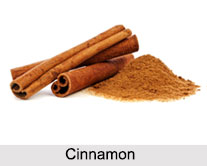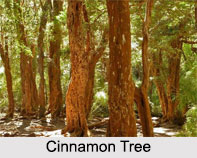 Cinnamon is one of the most important spices of India and is grown in different parts of India. The quality of cinnamon depends, among other factors, on the region where it is grown. Pure cinnamon is free from any admixture with cassia, which is considered inferior to the former in appearance, flavour and odour.
Cinnamon is one of the most important spices of India and is grown in different parts of India. The quality of cinnamon depends, among other factors, on the region where it is grown. Pure cinnamon is free from any admixture with cassia, which is considered inferior to the former in appearance, flavour and odour.
Etymology of Cinnamon
The Botanical name of Cinnamon is "Cinnamomum zeylanicun Blume" and it belongs to the family of "Lauraceae". It is also called "Darchini" in Hindi, "Daruchini" in Bengali, "Lavangpattai" in Kannada, "Darushila" in Sanskrit and "Sanna-lavangapattai" in Tamil.
Properties of Cinnamon
Cinnamon displays antiviral, antibacterial and antifungal properties. It also contains large amounts of antioxidants. The antioxidants in cinnamon have been found to have anti-inflammatory effects. It is also high in manganese and contains small amounts of calcium and fibre. It is aromatic, astringent, stimulant and carminative.
Use of Cinnamon in Cuisine
 Cinnamon is largely used for adding flavour in food. It has a delicate fragrance and a warm agreeable taste. It is extensively used as a spice or condiment in the form of small pieces or powder. It is used in beverages, pickles, chutneys and ketchup. It is also used in various types of baked foods, confectionary and drinks preparations. In baking it is used for both colouring and flavouring.
Cinnamon is largely used for adding flavour in food. It has a delicate fragrance and a warm agreeable taste. It is extensively used as a spice or condiment in the form of small pieces or powder. It is used in beverages, pickles, chutneys and ketchup. It is also used in various types of baked foods, confectionary and drinks preparations. In baking it is used for both colouring and flavouring.
Use of Cinnamon in Medicine
Cinnamon has a number of medicinal virtues. As a part of home remedy its decoction is used to combat cough. It prevents nervous tension, improves complexion and memory. Common cold can be effectively cured with the use of cinnamon. Coarsely powdered and boiled in a glass of water with a pinch of pepper powder and honey, it can be beneficially used as medicine in cases of influenza, sore throat and malaria. Its regular use during the rainy season prevents attacks of influenza. Cinnamon helps cure nausea, vomiting and diarrhoea. It stimulates digestion.
Cinnamon is often used as a good mouth freshener. Applying a paste of finely powdered cinnamon mixed in water on the temples and forehead readily cures headache caused by exposure to cold air. Paste of cinnamon powder prepared with a few drops of fresh limejuice can be applied over pimples and blackheads with beneficial results. Cinnamon is highly beneficial in the treatment of several other ailments, including spasmodic afflictions, asthma, paralysis, excessive menstruation, uterus disorders and gonorrhoea. Cinnamon can be used for natural birth-control. It indirectly helps the secretion of breast milk.




















